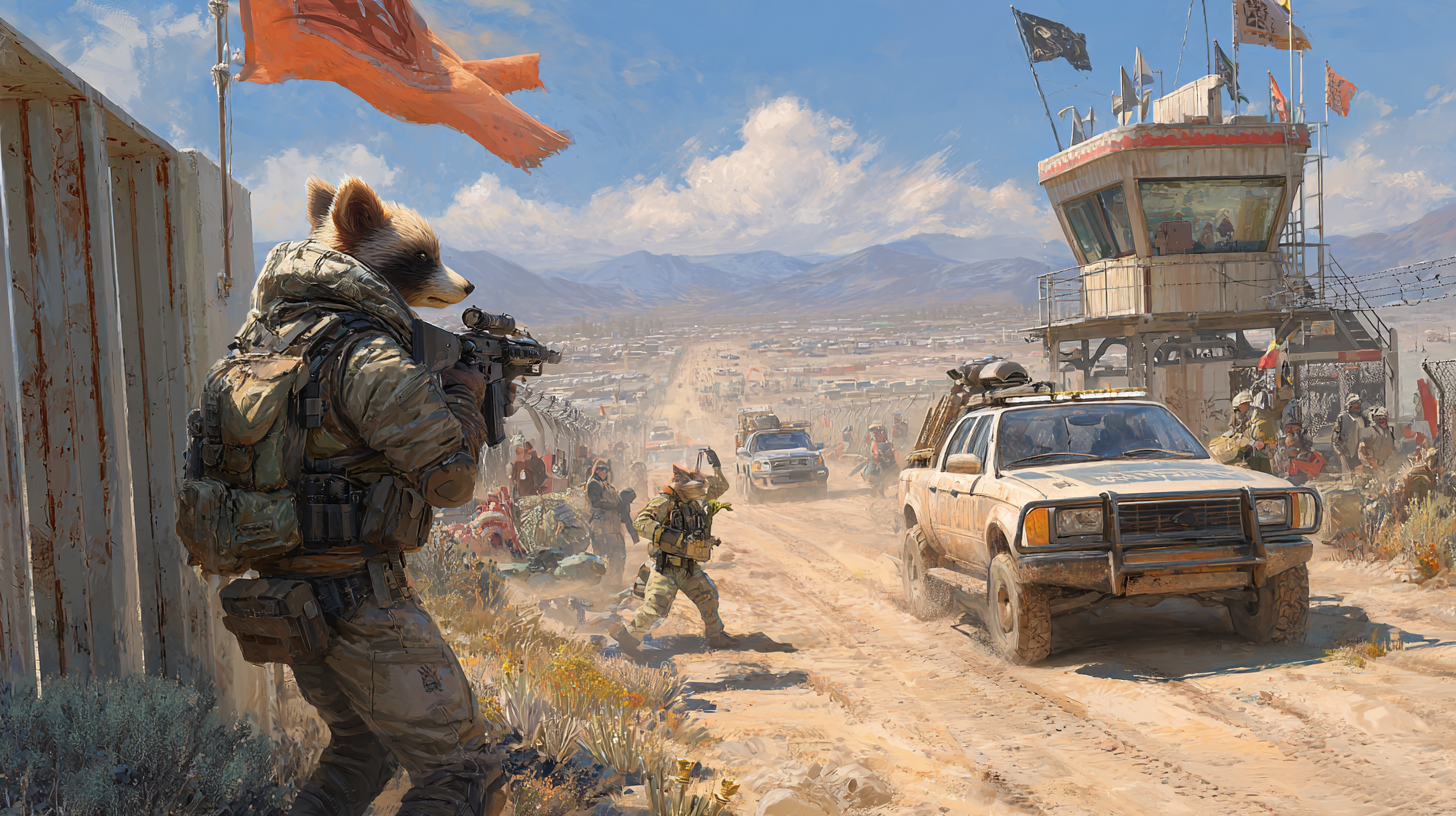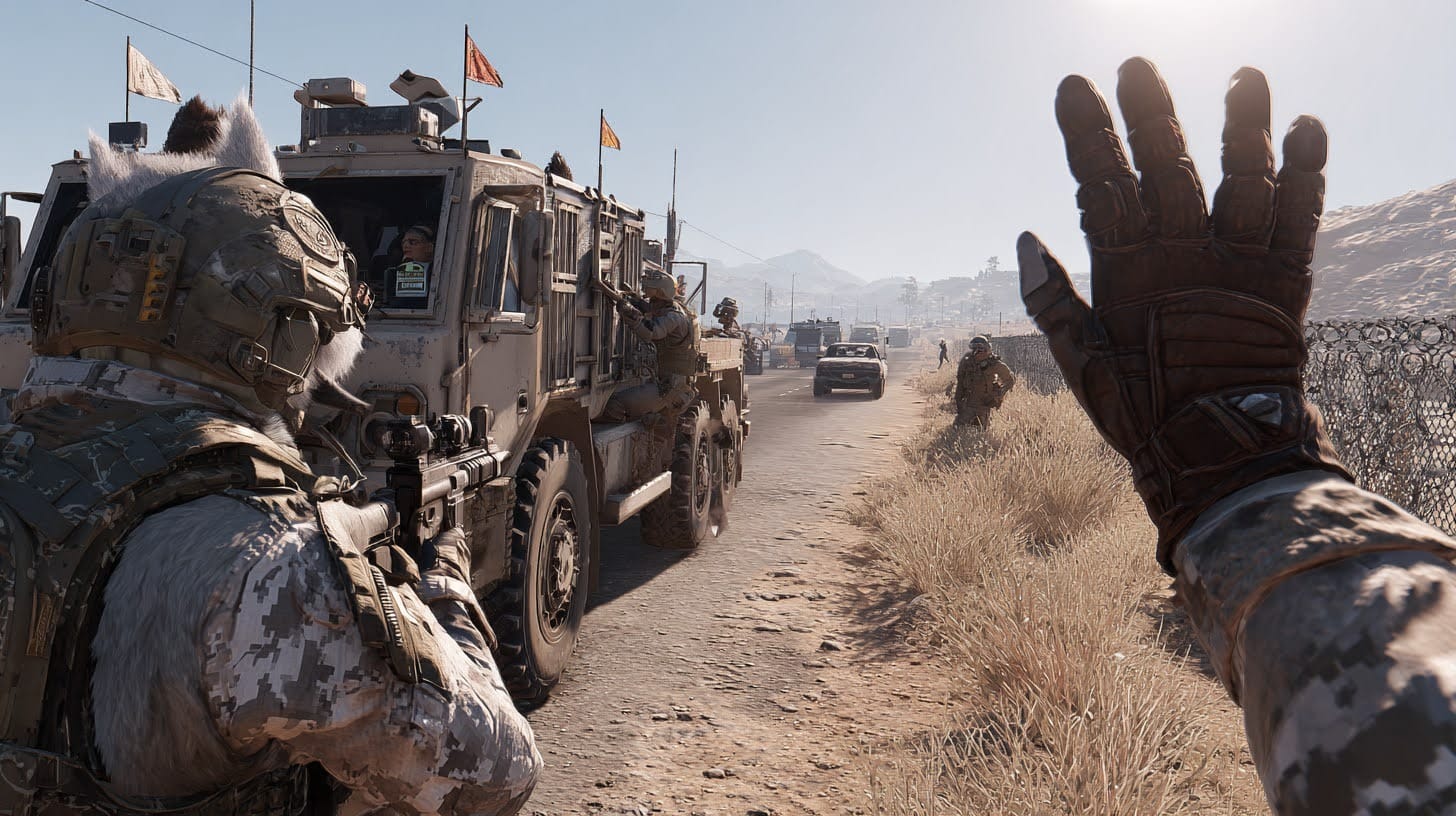JARLS: The Crossroads

"One dusty world, too many flags, and nowhere to hide."
An anthropomorphic sci-fi setting for Just Another Rules-Light System (JARLS)
Core Premise
On a distant colony world — part desert, part contested trade hub — the frontier city of Port Meridian sits at the edge of a war nobody fully understands. Offworld megacorps, independent militias, smugglers, foreign advisors, and desperate locals collide in a place where loyalties shift with the next shipment or the next whispered betrayal.
And yes — everyone’s an animal. Not cartoonishly so, but grounded, like Albedo or Usagi Yojimbo: species as subtle signifiers of culture, not stat bonuses.
Species as Narrative Flavor
Instead of stats, species choice provides descriptive hooks and story prompts, not bonuses. Think of it as a “soft tag” system — tables for cultural tone and interpersonal nuance.
Example at the table:
A raccoon engineer isn’t mechanically better at fixing a drive system, but their scavenger instincts and social network in the maintenance decks will color how they approach the situation.
Species Selection
Species – purely descriptive.
Cultural Anchor – a sentence about the social context (e.g., “Outer Rim colony-born,” “Corporate Fleet Academy,” “Independent hauler crew”).
A Grounded Universe
Energy weapons are vehicle- or emplacement-class only. Infantry support must work around mass and power limitations — belt-fed pulse rifles don’t exist, but a squad APC with a pulse laser does.
Personal Equipment
- Kinetic firearms: rifles (1d10), carbines (1d8), sidearms (1d6).
- Non-lethals: tasers (1d3), foam sprayers (situational).
- Armor: same DR tiers — ballistic cloth (-d2), flak (-d4), light ceramic (-d6).
Vehicles & Heavy Gear
Vehicles can mount energy or advanced weapons with clear constraints:
- APC-mounted pulse laser: 2d12, anti-armor, requires power cell maintenance and line-of-sight.
- AFV railguns: 6d12, ignores light cover, devastating vs. fortifications.
- FPV and autonomous drones: Recon first, limited kinetic strikes second.
You can make this feel real without adding extra math by scaling damage via dice size and letting the fiction enforce the rest.
Tone

- Casablanca: romance, cynicism, and quiet deals in back rooms.
- Kandahar, Afghanistan: war as background radiation — constant, disorienting, normalized.
- Anthro realism: the fox at the checkpoint, the bear running the airfield bar, the raccoon mechanic rebuilding a drone from scrap.
- Isolation: Communications fail; resupply isn’t guaranteed.
- Moral Dilemmas: You’re enforcing someone else’s claim on the colony — but how far will you go?
- Scale: Skirmishes are intimate and deadly; firefights are over in moments.
- Emergent Politics: Every faction move changes the board; actions have cascading consequences.
Setting Mechanics
Stress stays as-is, but tilt triggers toward paranoia, surveillance, and moral compromise.
Clocks drive the story:
- Faction Tensions: When filled, the city erupts.
- Security Clampdown: Patrols increase, checkpoints tighten.
- Supply Chain: When empty, everything grinds to a halt — ammo, meds, even coffee.
Resources: Track local currency, goodwill, and influence.
Character Playbooks
Sample Hooks
A downed drone in the desert carries encrypted intel every faction wants.
The resistance needs to smuggle a defector past corporate checkpoints.
A sudden assassination tips the city toward chaos; everyone’s scrambling for leverage.
Someone’s stealing med shipments meant for the refugee district — and selling them offworld.
The old radio relay on the edge of town is sending ghost signals.
Setting Flavor
Species as subtle culture markers:
- Canine tribes = loyal, pragmatic, often serving as guides or fixers.
- Felines = independent contractors, mercenaries, or quiet operators.
- Avians = couriers, scouts, information brokers.
- Ursines = heavy labor, logistics, or security muscle.
No lasers in holsters: Weapons are grounded, industrial, and scarce; energy weapons are vehicle-mounted, not personal.

Scenario: “Dead Air”
Port Meridian is buzzing. Someone hijacked the abandoned radio relay on the edge of the desert, and now it’s broadcasting coded bursts every few hours. Every faction — the corps, the militias, the locals, and the smugglers — want to know who’s behind the signal and what it means.
The PCs are hired to find the source, secure the site, and deliver proof of who’s running the station. What they find will spark chaos, paranoia, or opportunity — depending on how they play it.
Mission Hooks
Choose one or roll a d6:
- Corporate Contract: A “consultant” hands you a fat advance to retrieve the broadcast data — and destroy the transmitter.
- Resistance Request: The local underground needs to know who’s leaking their routes.
- Third-Party Broker: Someone in the city’s Neutral Zone bar says the signal isn’t random — it’s a treasure map.
- Debt Marker: Someone you owe a favor insists you investigate quietly.
- Crew Agenda: A PC’s personal connection disappeared in that sector two weeks ago.
- Open Call: Word on the street is that whoever controls the signal controls the city’s comm grid.
Scene 1: Briefing at the Hub
Start in Port Meridian’s central hub — a crumbling terminal now serving as an impromptu command center.
NPCs introduce competing agendas:
- A corp handler in polished body armor (slick but threatening).
- A local fixer who’s “just trying to keep things balanced.”
- A streetwise runner with a flash drive full of bad leads.
Tone Toggle:
- Serious: Lean into cold dialogue, veiled threats, and tense silence.
- Loopy: Make the fixer a fast-talking chaos agent handing out jobs like party favors.
Scene 2: The Journey
Travel through desert scrub, abandoned checkpoints, and burned-out convoys to reach the radio relay.
Roll for complications:
- 1-2: Drone surveillance sweeps the road.
- 3-4: Militia checkpoint demands “tolls.”
- 5-6: Sandstorm rolls in, visibility near zero.
Clocks:
- Detection (4 segments): Fill on noise, violence, or obvious movement.
- Resource (6 segments): Supplies, water, and ammo draining with every delay.
Scene 3: The Relay Station
The relay is a rusting husk, powered by scavenged solar rigs and jury-rigged batteries.
Inside:
- Improvised living space with maps, gear, and a partially scrubbed data core.
- A faint odor of ozone — someone left in a hurry.
Complications:
- Drone: A stealth recon bot still pings the area, broadcasting bursts.
- Evidence: The broadcast pattern matches corporate encryption protocols.
- Survivor: A local tech, panicked and babbling, claims they just maintain the hardware.
Tone Toggle:
- Serious: Play the survivor as broken, terrified, and barely coherent.
- Loopy: Make them an over-caffeinated conspiracy theorist blaming “desert ghosts.”
Scene 4: Escalation
Whatever the PCs do, someone notices:
Trigger Stress rolls as tension spikes — negotiations, gunfights, or chaotic retreats are inevitable.

Scene 5: Extraction
Potential outcomes:
- Clean Sweep: PCs secure the intel, cover their tracks, and walk away with leverage.
- Dirty Exit: They get the data but leave behind evidence or collateral damage — factions escalate against them.
- Full Burn: Ambush, betrayal, or a botched retreat turns the relay into a smoking crater.
Tone Toggle:
- Serious: Play up irreversible consequences — reputations shattered, city factions on high alert.
- Loopy: Escalate into farce — dropped drives, mistaken identities, frantic comm chatter as everything unravels.
Faction Clocks
NPC Seeds
Closing Beats
End the session with threads unresolved — someone angry, someone suspicious, someone missing.
Push a new hook tied to the fallout:
- The corp wants a quiet sit-down.
- The militia blames them for the signal.
- The “ghost broadcast” keeps running anyway.

Appendix: Additional Playbooks
Grunts
Rear Echelon Personnel & Civilians
How They Play
These roles add flavor and stakes without adding crunch.
Civilians and support staff shine in tense, socially or logistically driven sessions — investigations, maintenance failures, or political crises.
In combat, they’re vulnerable but not helpless — a sidearm and low DR keep scenes cinematic without erasing tension.

Credits & License
The Crossroads is an unofficial, noncommercial, fan creation as a tribute to Steve Gallacci's Albedo Anthropomorphics. No challenge to existing copyrights is intended.
This work is licensed under Creative Commons Attribution 4.0 International. You are free to share and adapt this material for any purpose, including commercial use, as long as you provide appropriate attribution.